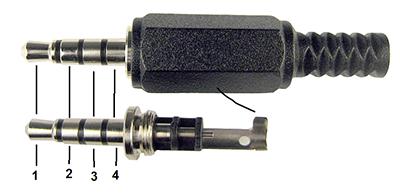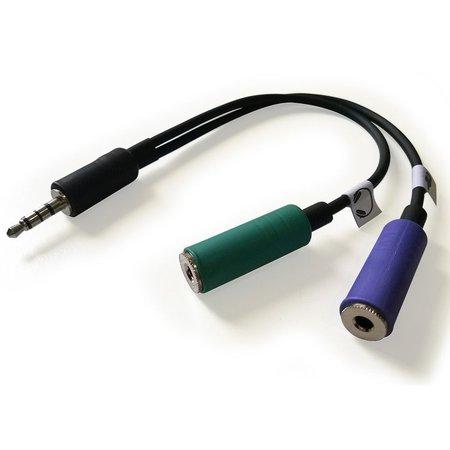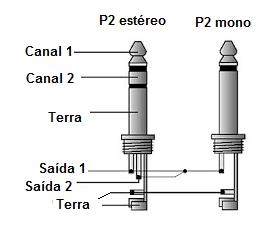In order to use the phone's audio capabilities, first of all we need to have access to its internal circuits.
The common cell phones using a P3 plug as shown in Figure 1.

These 3.5mm plugs are used in most mobile phones.
Identification of the terminals:
1 - The headphone left channel output
2 - The headphone right channel output
3 - Common (ground)
4 - Microphone input
Adapter cables for mono and stereo jacks (mono and stereo plugs) P2 can be found in the specialized trade, as the one shown in Figure 2.

The plugs are shown in Figure 3 and it is with them that we can work when we do not connect the adapter to a device that already has a plug.

But for those who want to do electronic projects using this access to a mobile it is essential to know the electrical characteristics of it.
Thus we have:
Audio Outputs:
They are usually used audio amplifiers with low impedance outputs.
- Output Impedance: 33 Ω (this may vary between 20 and 100 Ω depending on the type)
- Capacity: 420 mW
- Response Curve: 20 to20 kHz
Remember that the specified impedance is for 1 kHz. Thus, in a signal generator, for example, operating in a fixed frequency of another value, the impedance should be reconsidered.
Considering the impedance of an inductive load, for example, the low impedance winding of an output transformer is 8 Ω at 1 kHz, if we consider the formula:
XL = 2 x φ x f x L
We see that the reactance is directly proportional to the frequency, therefore, operating with 5 kHz the impedance is 40 Ω.
For the response curve, in fact, the given values go up to 20 kHz, but the circuit reaches usually a little more, allowing us to obtain ultrasonic signals.
Some applications, for example, the High Frequency, generates signals of much higher frequencies reaching 24 kHz.
We could not find specifications for the used speakers in mobile phones, but for their size, they should reach frequencies above the audible limit, enabling the development of interesting projects.
Microphone input
This input has an impedance of 640 Ω and a sensitivity that depends on the type. The table below shows a comparison of the signal levels to get the best recording and which can be used as a reference. This means that we can connect to this input several circuits as small mixers, inductive sensors of signals for telephone recordings, etc.
What can we do with the audio from a mobile phone?
Analyzing the characteristics of these circuits and the availability of many applications that involve sound, we can do lots of interesting things that will be explored in the articles in this section, such as:
Signal gun
Signal generator
Function generator
Voice distorter
Telephone sensor
Testing the hearing ability
Mixer
Auxiliary amplifier
Amplifier for hearing aid
Ultrasonic ear
Ultrasonic sensor
Decibel meter (sound level meter)
Audio Spectrum Analyzer
Sonar
Sound recognizer
Sonic remote control (Vox)
Of course that on this list we only some of the project possibilities which as far as possible will be explored in this section.




